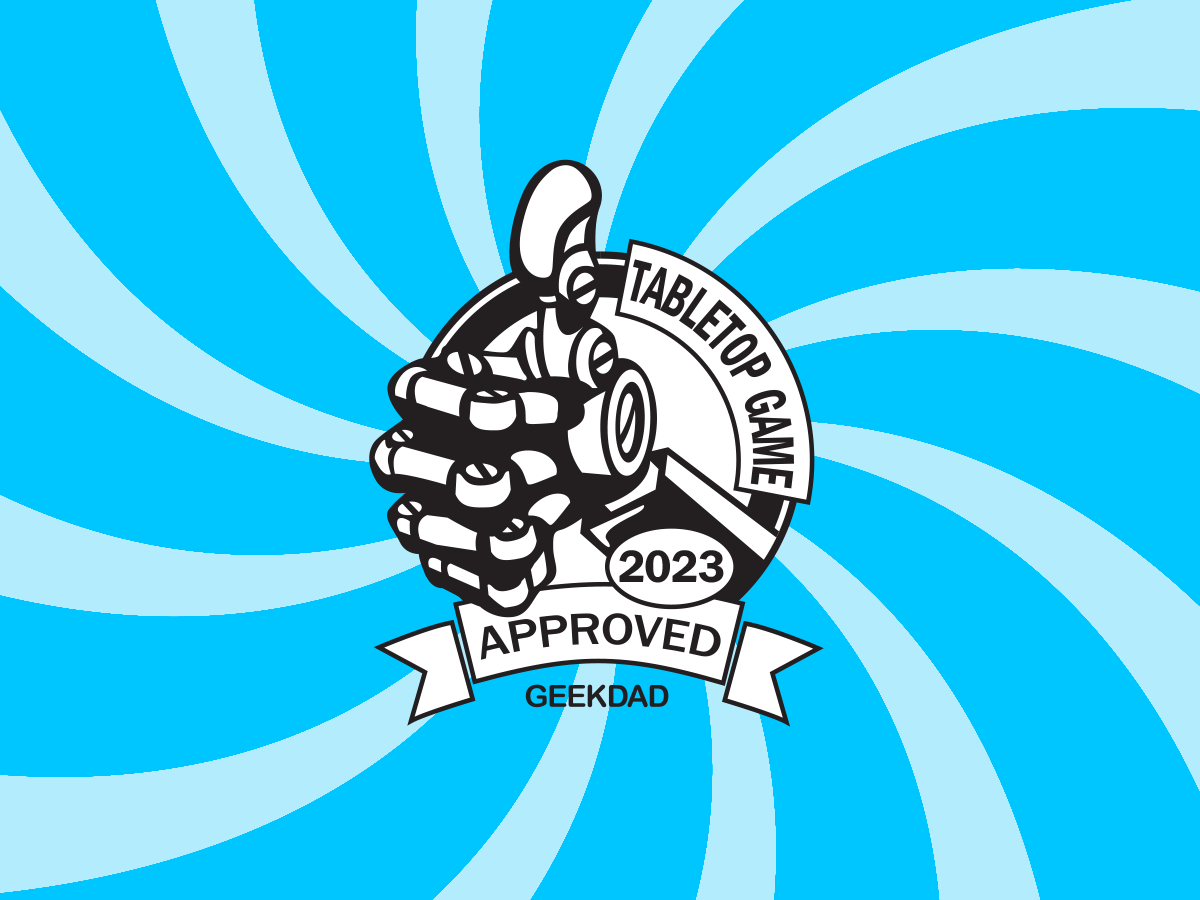‘Frosthaven’: A Bigger, Better, Cooler ‘Gloomhaven’
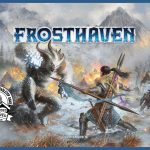
Your band of mercenaries has made it to the far north, a small outpost called Frosthaven in the Frozen Wastes. What adventures await you here?
What Is Frosthaven?
Frosthaven is a legacy-style cooperative game for 1 to 4 players, ages 14 and up, and is the sequel to Gloomhaven. The play time varies by scenario, roughly 2 hours per session but this can be affected by the number of players, the complexity of the particular scenario, and some other factors. Frosthaven was originally funded through Kickstarter in 2020, delivered to backers in late 2022 and early 2023, and is now available to purchase from Cephalofair Games, with a price tag of $250 (or more, if you want to bundle some of the extras with it). Or if you don’t mind waiting a bit longer, you can pledge $180 for the second printing of Frosthaven through the current Backerkit campaign. Frosthaven is a standalone game and you don’t need to play Gloomhaven first, though it uses a lot of the same rules, with a few new additions.
Frosthaven was designed by Isaac Childres and published by Cephalofair Games, with artwork by Francesca Baerald, David Demaret, Alexandr Elichev, and Josh T. McDowell. There’s also a host of additional names in the rulebook for developers, scenario writers, graphic design, and more—too many for me to list here.
What Is a Legacy-Style Game?
The term “legacy game” has been around for over a decade now (starting with Risk Legacy) but I find it’s still helpful to clarify what I mean, especially if you haven’t played one yet. Legacy games are games in which you will make permanent changes to the game as you play, often as a result of decisions you make over the course of the game. Nowadays, this can include writing on or adding stickers to game components, tearing up cards, scratching off some coating to reveal hidden information, and more. In most cases, legacy games are also campaign games, which means you’re intended to play through some number of sessions before you “complete” the game—at which point the particular state of your copy of the game is the “legacy” that you and your fellow players have created, potentially unique from any other copy that has been played.
There are a lot of components in Frosthaven that are revealed as you reach certain parts of the story, stickers that are added to the map, and so on, and the element of surprise as you open an envelope or lift a flap is part of the appeal. Because of that, it’s hard to talk in detail about the game, especially the components themselves, without giving a few spoilers. That said, I’ll try to keep significant spoilers to a minimum and only share what’s really necessary for explanation—primarily I’ll show photos from the first scenario so that they’re things you’d see very early on.
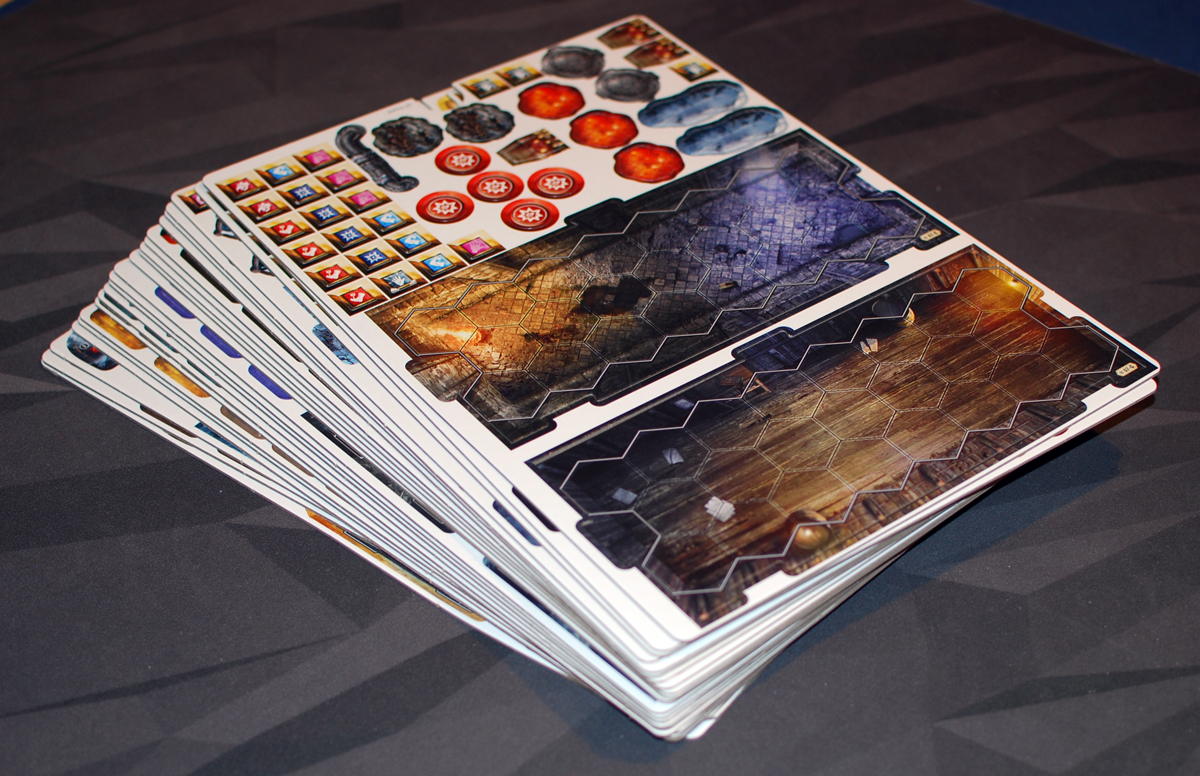
Frosthaven Components
Because of the hidden/unknown components, I’ll list the “known” contents of the box but will leave out some of the details. When you first open the huge box, you’ll find a big stack of cardboard to punch out, and underneath that are a few plastic trays of cards, envelopes, boxes, books, and some other materials. There’s a handy sheet that tells you how to get things sorted to some extent, though there are some things that you’ll need to further organize yourself.
Here’s what comes in the box:
- Map board
- Scenario book
- Section book
- 38 Map tiles
- 225 Overlay tiles
- Alchemy chart
- Campaign sheets
- 6 Sticker sheets
- Puzzle book
- 5 Scenario flowcharts
- 327 Monster standees
- 17 Sealed envelopes
- Element board
- Round marker
- 6 Element tokens
- 18 Character miniatures
- 17 Character tuckboxes
- 4 Reference cards
- 29 Building cards
- 10 Personal Quest cards
- 24 Random Room cards
- 24 Random Setup cards
- 247 Event cards
- 379 Item cards
- 25 Random Item cards
- 15 Random Item Blueprint cards
- 60 Battle Goal cards
- 59 Loot cards
- 7 Random Scenario cards
- 45 Challenge cards
- 344 Monster Ability cards
- 55 Town Guard cards
- 165 Attack Modifier cards
- 13 Divider cards
- 49 Monster Initiative Order tokens
- 25 Scenario Aid tokens
- 32 Boss Stat cards
- 48 Monster Stat cards
- 6 Monster Stat sleeves
- 4 Character dials
- 30+ Plastic bases
- 60+ Damage tokens
- 20+ Loot tokens
- 100+ condition tokens

First up, there are a lot of map tiles—these have notches and knobs on the edges so that they can attach to each other, jigsaw-style, and each tile is double-sided so you get different artwork for the background. They’re labeled with numbers and letters, so all of the tiles of the same shape share a number. There isn’t an organizer for these included in the base box, so they just get piled on top of the trays.
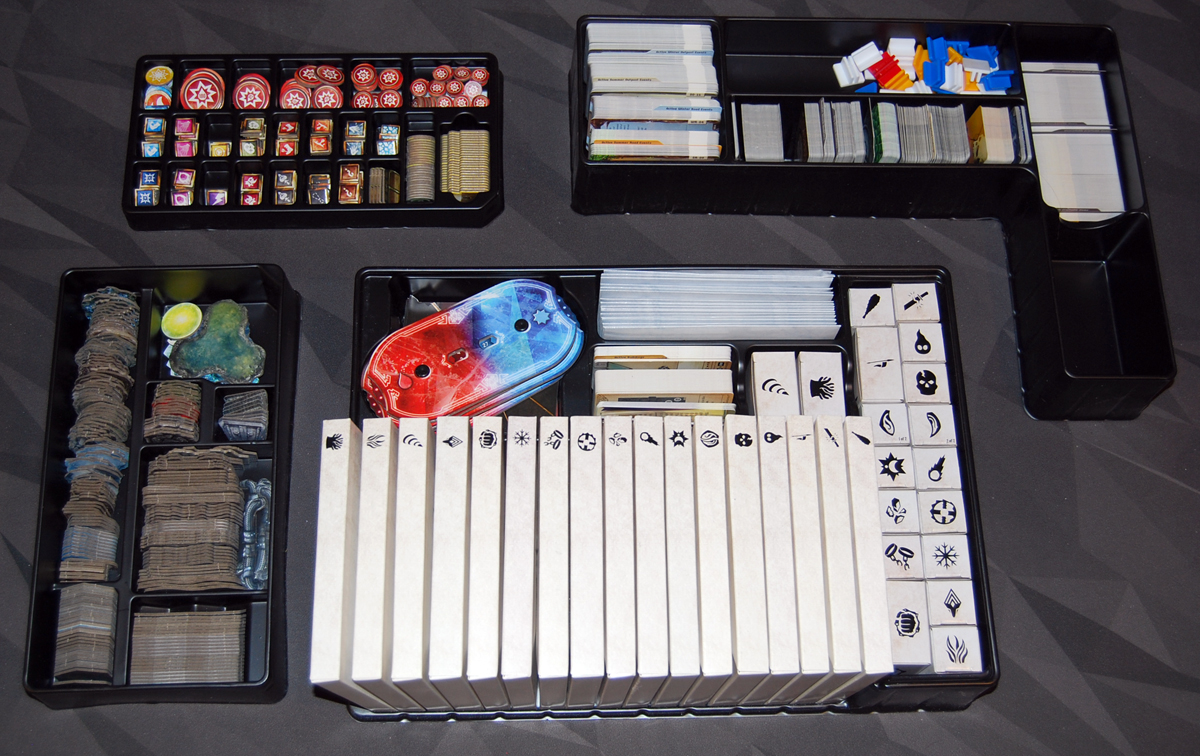
The photo above shows the plastic trays: the two on the left nest into each other (with lids); the top one includes all the various status token and damage tokens, and the larger tray has all of the overlay tiles for terrain, doors, special locations, and so on.
The tray on the top left has most of the cards: lots of event cards, battle modifier cards, and item cards. Most of these have little divider cards to separate the available and unavailable cards, but the way they’re designed is that “Available” is printed on one side and “Unavailable” is printed on the other, so you need to be careful which side you’re looking at. This tray also included all of the cards for the enemies (in that empty well on the right), but the way the game has you organize them (see below), this well ends up empty. One thing that disappointed me about the divider cards is that the tabs stick up over the height of the trays—and for storage, you’ll pile the books and tiles on top of them, which means the tabs get squashed. There was an article about how they hired a submarine engineer to get everything to fit into the box—and it’s an impressive feat, for sure, but a lot of it feels like it fits when it’s new, but isn’t designed for good storage once everything is punched out and in use.
The large tray on the bottom is intended to be left at the bottom of the box. It has the health/XP dials, large enemy cards, building cards, a bunch of sealed envelopes, and then lots of boxes. The smaller boxes along the right are miniatures for all of the player characters, and the flat boxes are the other components for each of the character classes.
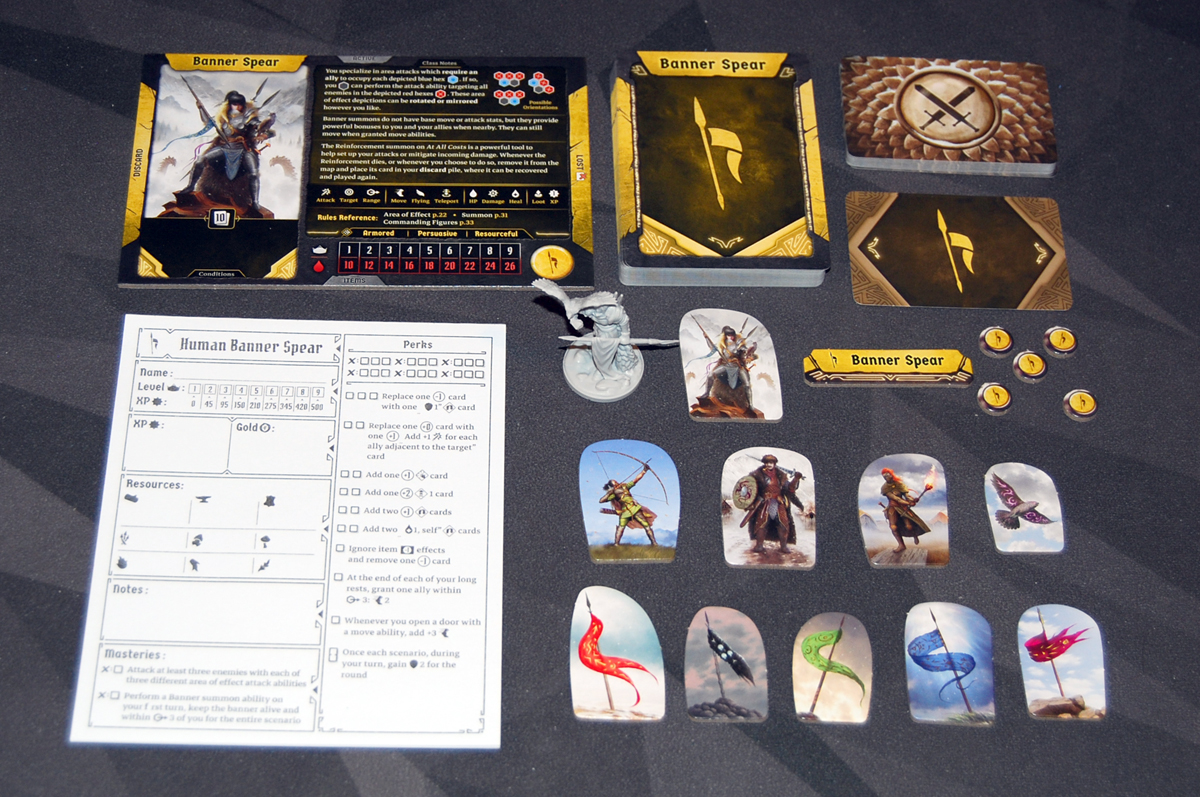
Each class has its own set of components so they vary a bit, but the photo above shows is a sample. The Banner Spear is one of the starting classes (and the one I started with). Each box has a player board, a pad of character sheets, a deck of action cards and a deck of modifier cards, an initiative token, and potentially some other tokens. The Banner Spear has a lot of abilities that summon allies or banners, but some characters have none or have other types of tokens. The character itself has a corresponding miniature, but there are also cardboard tokens for each character in case you prefer to use those instead.
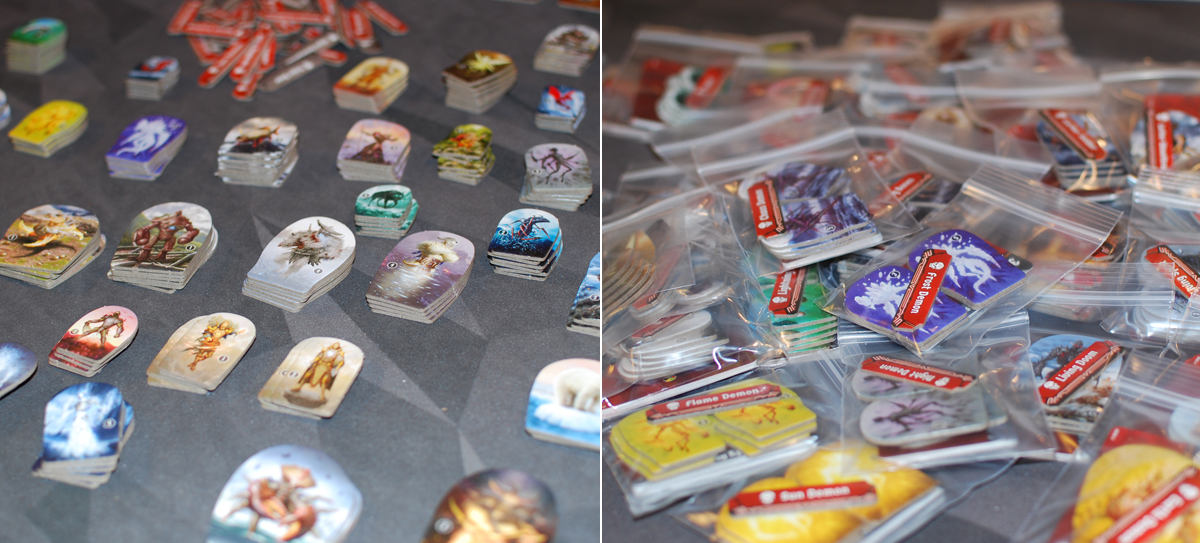
The bulk of the cardboard punchouts are the enemies. There are over 40 monsters, demons, guards, machines, and creatures, and there are 6 to 10 copies of most of them aside from the bosses. If you have Gloomhaven, you’ll notice that there are quite a few that you’ve seen before. Each enemy has the standee tokens, an initiative banner, and a small deck of action cards, and the setup sheet tells you to bag these up (with the included plastic baggies) and then, well, pile them all into the box, on top of the stacks of map tiles. While this does get everything to fit in the box, it’s a pretty poor system, particularly when you’re looking for specific enemies for a scenario setup. I ended up labeling all the bags with a marker and lining them up in a shoebox in alphabetical order.
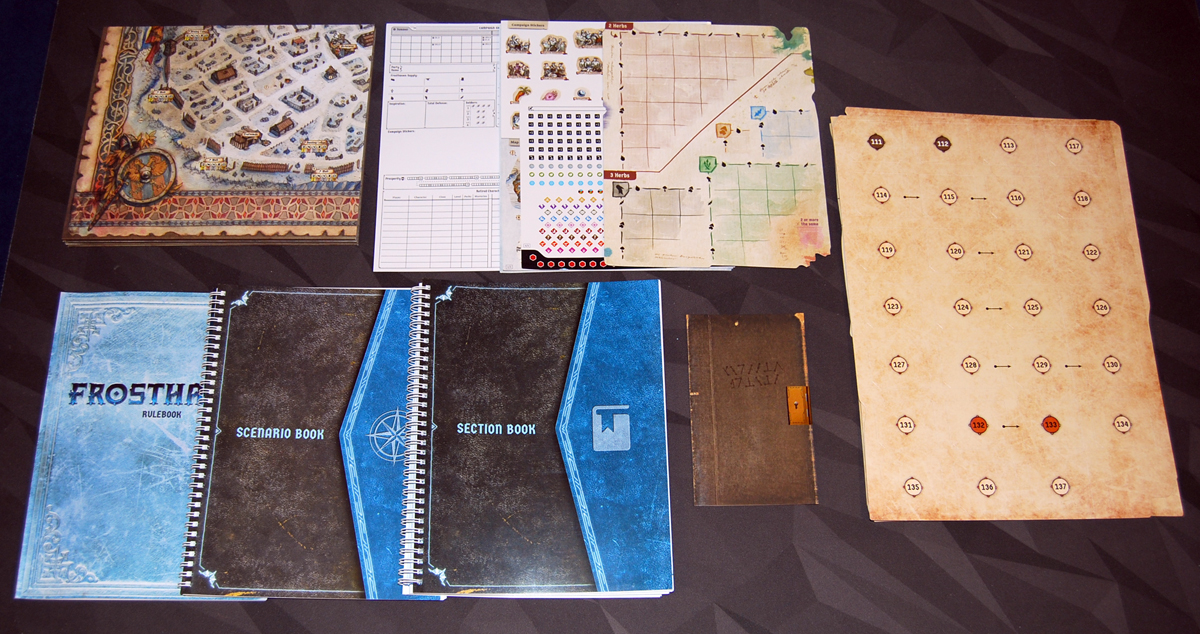
There’s a large board that serves as a map—it has the Northern Coast on the top half, and then a close-up of the Frosthaven outpost on the bottom. You get a pad of campaign sheets, a few sticker sheets (which you aren’t supposed to examine too closely), an alchemy chart, a few books, and scenario flowcharts, plus a little sealed puzzle book.
In case you’re already familiar with Gloomhaven, the rules and sections that are new to Frosthaven are highlighted so you can quickly skim to find the new material. This time, in addition to the scenario book, there’s also a section book. In Gloomhaven, I noted that although you weren’t supposed to know what was on the other side of a door until you open it, it was easy to glance at the setup map and see what was coming. Now, the scenario setup shows you the whole map layout but only includes monsters in the rooms you can see at the start of a scenario, with instructions to look up a particular page in the section book when you open a door (or other events trigger). The section book is also where you’ll find timed events or sometimes the results of decisions you make.
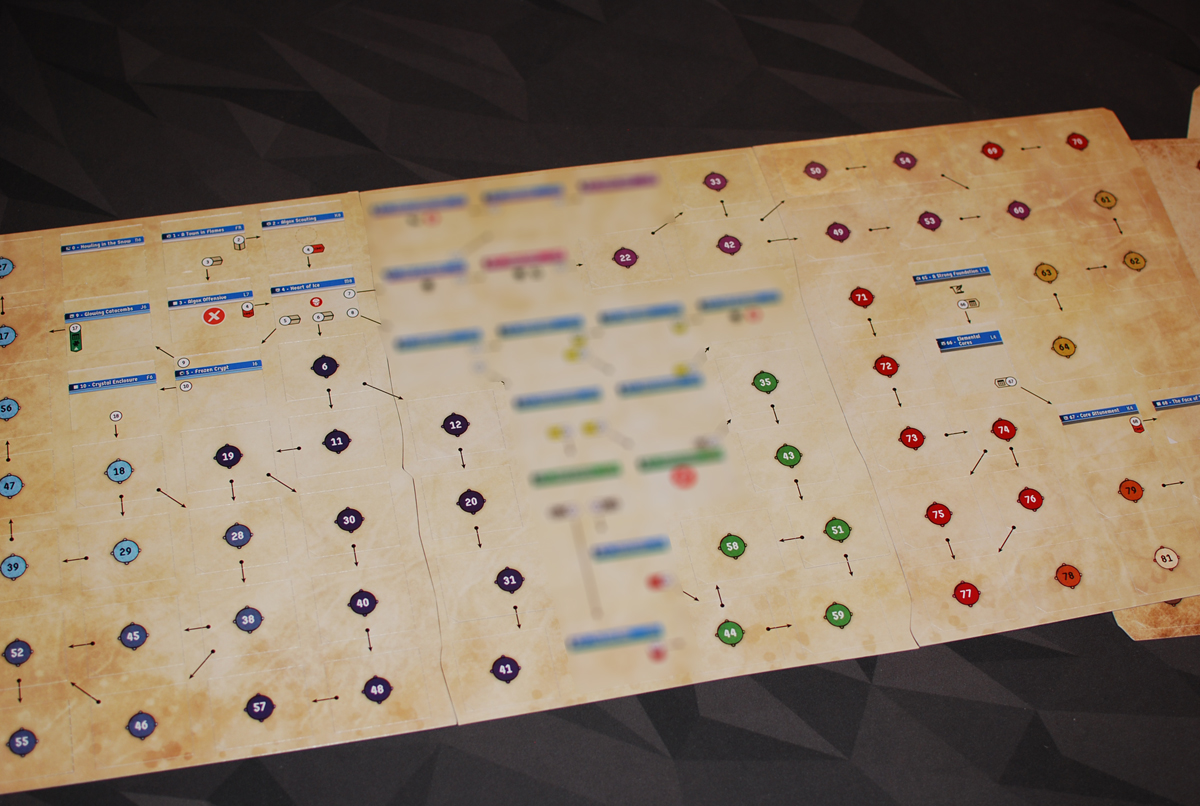
The scenario flowcharts are large sheets that show how one scenario leads into the next. Some are linear paths, and other times there are branching paths that you’ll take depending on the outcome of a scenario. There are scenarios that will unlock after a certain amount of time has passed, and there are others that you can’t play until you’ve made enough progress in the puzzle book.

As you unlock scenarios, you open the flap on the flowchart, which reveals a sticker to put onto the board. The location coordinates are listed on the board, though it would have been nice to have it printed on the margin of the sticker too. The board itself just has the numbered circles, and when you place a sticker it will add the scenario title, as well as some more illustrations about that scenario. There will even be times when you place stickers on top of other stickers. Some stickers overlap the sections of the board that fold, and those stickers are cut into two pieces, but I’ve found that the cuts don’t always line up exactly right.
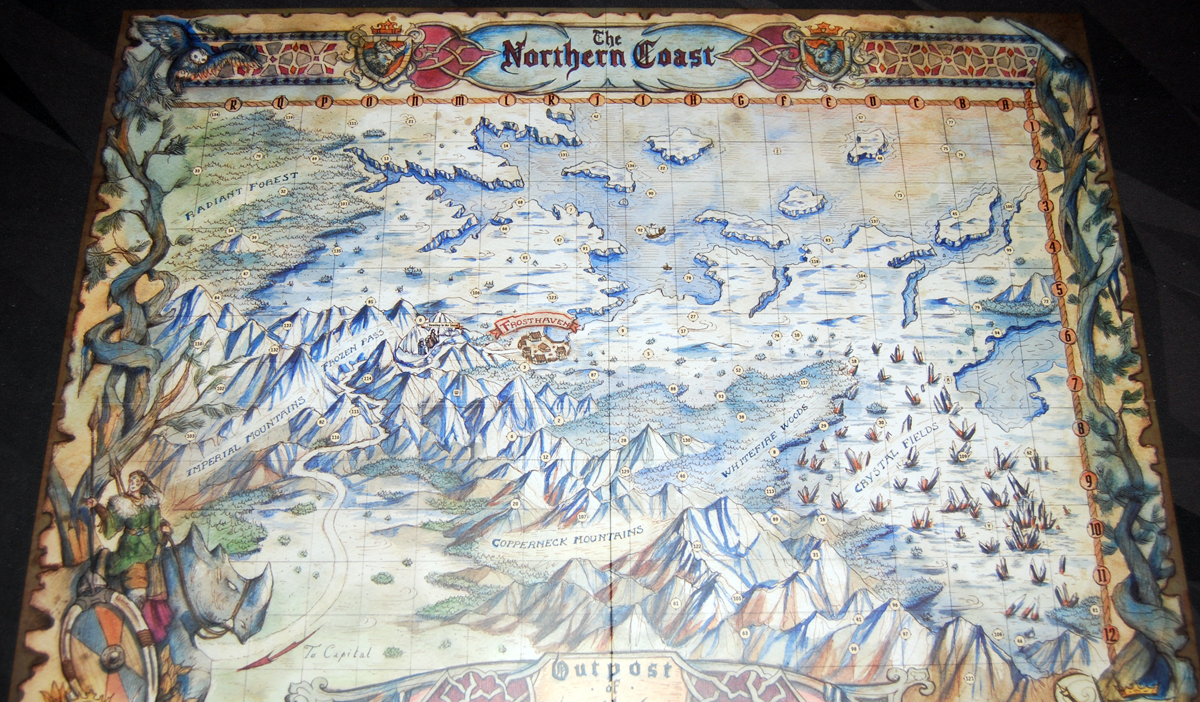
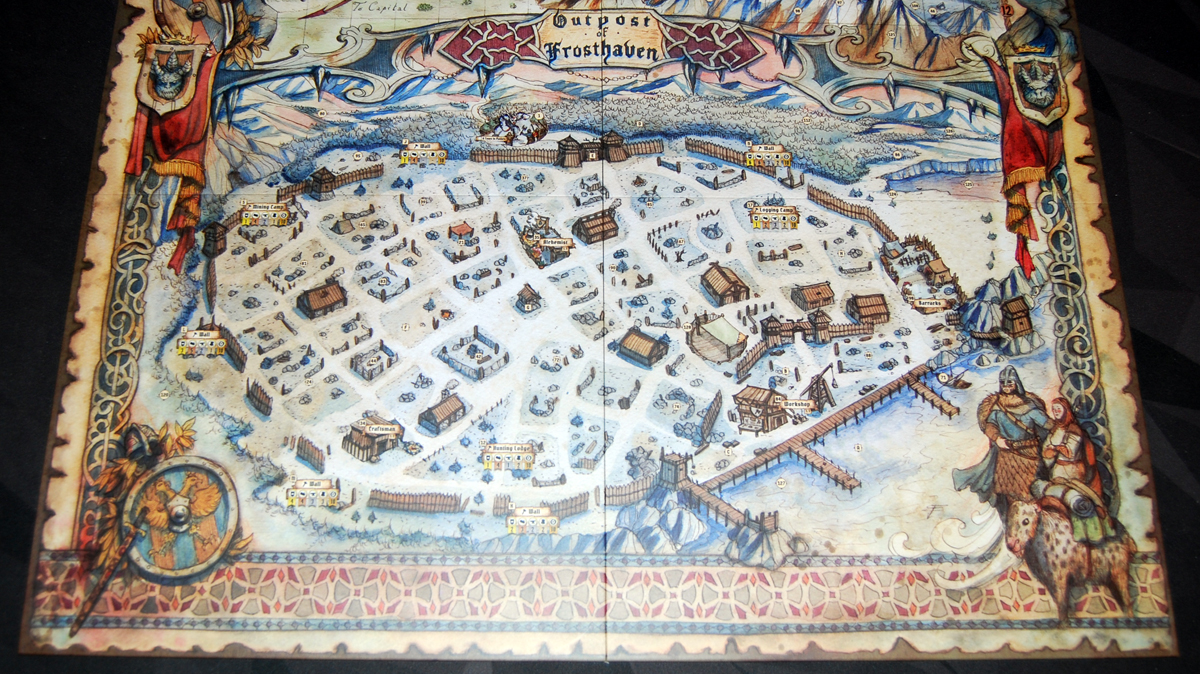
The Outpost section of the board starts with a few buildings, but the walls are incomplete and most of the outpost consists of empty lots. As you play through the campaign and build up the prosperity level of the outpost, you’ll be able to level up existing buildings and build new ones, giving you access to stronger abilities. The building stickers stack as you level them up, and it’s fun to see the little details that are added as each one is improved.

How to Play Frosthaven
Since the core of the gameplay in Frosthaven is the same as Gloomhaven, I don’t want to get too bogged down in the mechanics here. You can read my review of Gloomhaven for a more detailed breakdown, and I’ll mostly highlight the differences here.
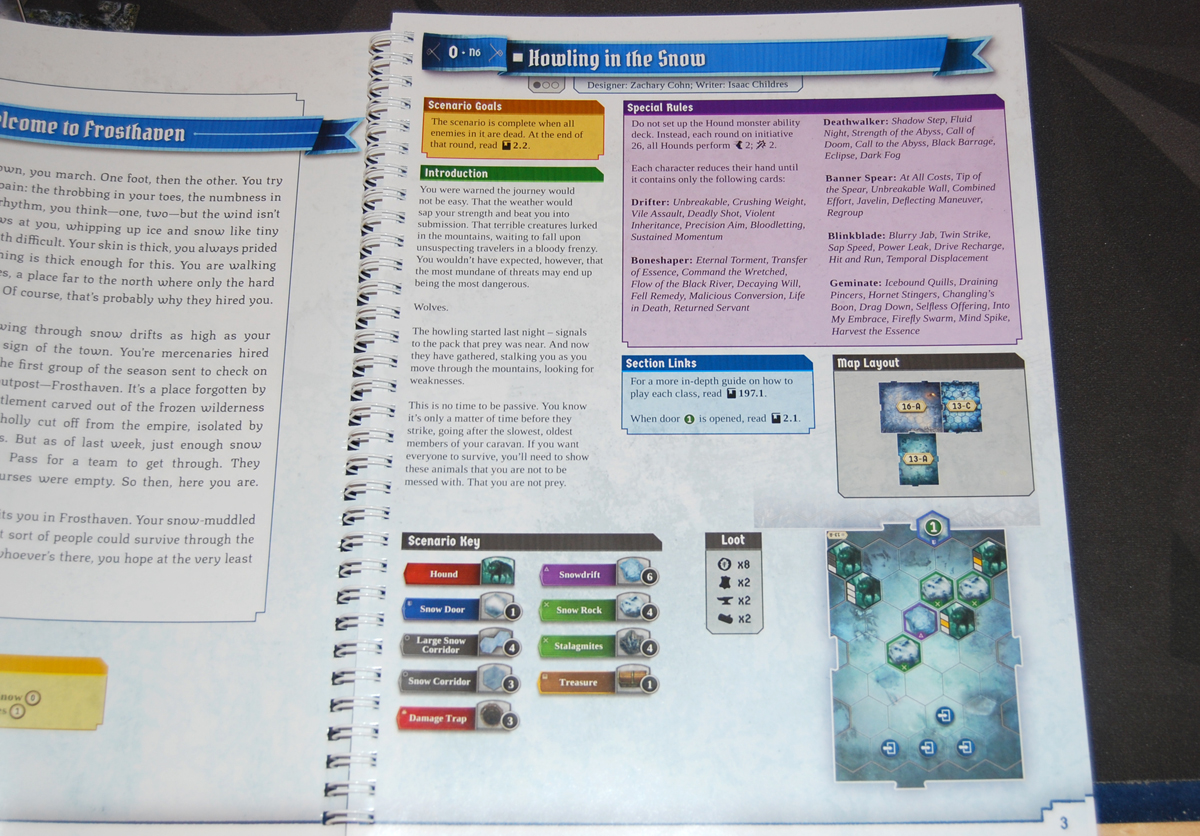
A quick sketch of the gameplay: each scenario has its own setup map, enemies, and various terrain features placed on the map according to the scenario book, and some have special rules as well. Each player has a hand of action cards that each have a top action and a bottom action—typically attack on the top and movement on the bottom, but this can vary greatly from character to character. On your turn, you choose two cards from your hand to play—this will determine both the initiative order for the players and give you the options for your turn. Each monster type on the board will also flip a card from their individual decks, which will determine their initiative and dictate their behavior.
When it’s your turn, you choose one of your cards to use the top action, and the other card uses the bottom action, moving around the map and (usually) attacking the enemies. Some cards—usually the more powerful actions—will be “lost” after you use them, meaning they’re unavailable for the rest of the scenario, but otherwise they go into a discard pile. If you run out of cards in your hand, you’ll have to rest to get the cards back from your discard, but you also lose a card when you rest—that means you have a limited number of turns before you have no more cards available and are exhausted, out of the scenario.
You also have a limited amount of health, which ticks down when you take damage—and, of course, if you run out of health, you’re exhausted for that scenario. You’re also allowed to lose cards to prevent damage, but that runs you out of cards sooner, so you need to maintain a careful balance between losing health and losing cards. Each scenario has its own objectives (defeat all enemies, last a set number of rounds, destroy a particular object) and loss conditions.
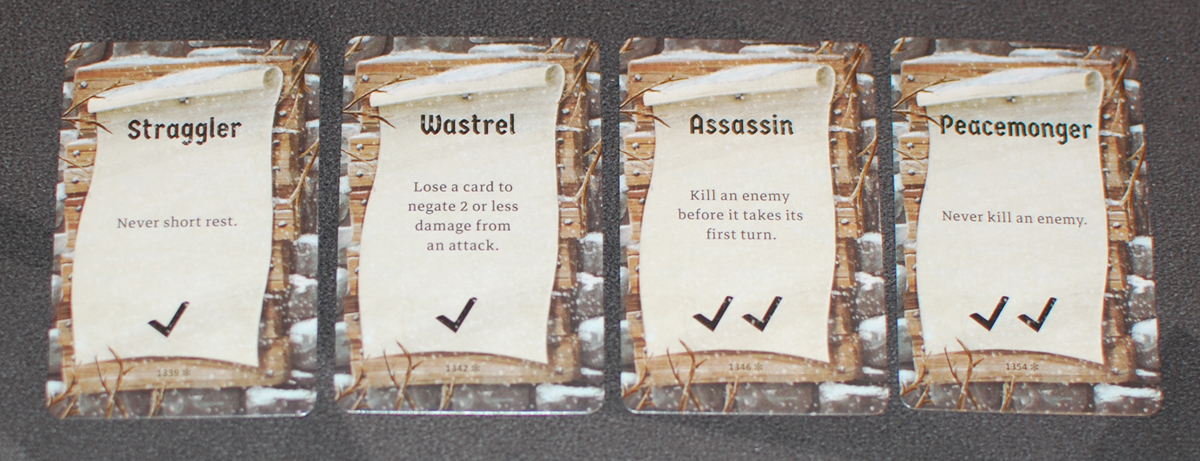
In each scenario, you’ll also have a battle goal—this will earn you checkmarks toward perks if you complete them, and they’re a bit like achievements: have more or less loot, kill a certain number of enemies, always move at the top speed, that sort of thing. Gloomhaven came with 24 battle goals; Frosthaven has more than double that. Perks will usually let you adjust your battle modifier deck or unlock a few other abilities.
As you earn XP, you’ll get to level up your character, which increases their starting health, gives you a perk, and lets you add a new card to your deck. (However, your hand size does not increase, so that means you’re swapping out a card for a more powerful card.) Each player has a secret personal challenge that serves as a long-term goal—if you complete the challenge, then your character retires and you start a new character.
What’s New in Frosthaven
Some of the changes are mostly variety: a few new conditions, terrain types, and a new way to gain loot that uses a deck of cards tied to the scenario itself. There are also some changes to the way line-of-sight is calculated and a few new types of actions.

One change is that the events now have seasons. Usually, at the start of each scenario, you’ll draw a road event, a bit of story that gives you some options, and then you flip the card to see the result of your choice. Now, you’ll draw either a winter road event or a summer road event, depending on the season according to your campaign sheet calendar.

The biggest change, though, is the Outpost phase. After most scenarios, your party returns to the Frosthaven Outpost. Each time this happens, you first mark off the next box in the calendar—some of these have section numbers pre-printed on them, and sometimes there will be section numbers that you’ve been instructed to add based on events or scenarios. When you reach one of these, you read that section of the book and resolve the outcome.
Then, you draw an Outpost event card (again, based on the season). Like the road events, these have a bit of story and some options to choose from, but they’re usually a different type of event that has some effect on the outpost rather than the scenario you’re about to play. They also include attacks on your outpost, which can damage or wreck your buildings, and these are resolved with a town guard deck that is similar to your character’s battle modifier deck.

Each building in your outpost has a corresponding card, and you’ll have an opportunity to use them after resolving the event. For instance, you may be able to buy resources, train soldiers, or brew potions. If a building is damaged or wrecked, you have to pay resources to repair them, and you lose their effects until they’re repaired. Upgrading a building will require you to be at a particular prosperity level, and you’re generally limited to building or upgrading one thing each Outpost phase.
Your campaign sheet also tracks things like your morale (which can be spent for repairs or extra building), your soldiers (used to boost defense during an attack), and shared resources. Just like your character can earn perks to tweak your battle modifier deck, the town guard also has perks to modify the town guard deck—though my party hasn’t gotten to that stage yet! There’s also a section at the bottom of the sheet to record when a character retires—by fulfilling their personal quest.
The Outpost phase is also when you’ll be able to craft items, buy items, brew potions, and level up characters when applicable.
Frosthaven is GeekDad Approved!
Why You Should Play Frosthaven
When I wrote up Gloomhaven several years ago, I was still in the middle of another campaign game so it was hard to set up a regular group to play it, and I’ll admit that I did not manage to make it very far, though I still have plans to get back to it eventually if I find the right group for it. This time around, though, I’m playing Frosthaven with two friends who did complete Gloomhaven themselves, and their enthusiasm and consistency mean we’ve already gotten further into the campaign than I did before. We’ve logged 20 sessions so far as of this writing, and I’ve even managed to retire my first character.
What I said about Gloomhaven still holds true for Frosthaven, but more so. It’s even more expensive and even bigger (both in box size and in scope). There are 137 scenarios on the flowchart, and while you won’t play all of them because some branches force you to choose one path or another, you’ll still have plenty to do. Each session takes our 3-player group between 2 and 4 hours to complete depending on the complexity, so even playing weekly I imagine this will take over a year to complete, possibly close to two. Even so, whenever we finish a scenario we’re usually itching to play more, and if I didn’t have so many other games in my queue (and, you know, other friends I also want to play games with) it would be tempting to play Frosthaven multiple times a week instead.
I think one of the key things that sets Frosthaven apart from other dungeon crawlers I’ve played is the way the cards function—picking two cards to set your initiative, and then getting to decide how to use those two cards once your turn actually comes up, gives you a couple of challenging choices while retaining some flexibility. The battle modifier cards, used instead of rolling dice, are another interesting feature. You always have the possibility of a critical fail or a critical hit in the deck, but you can modify a lot of the in-between using your perks, so you can tweak the deck to fit your play style.
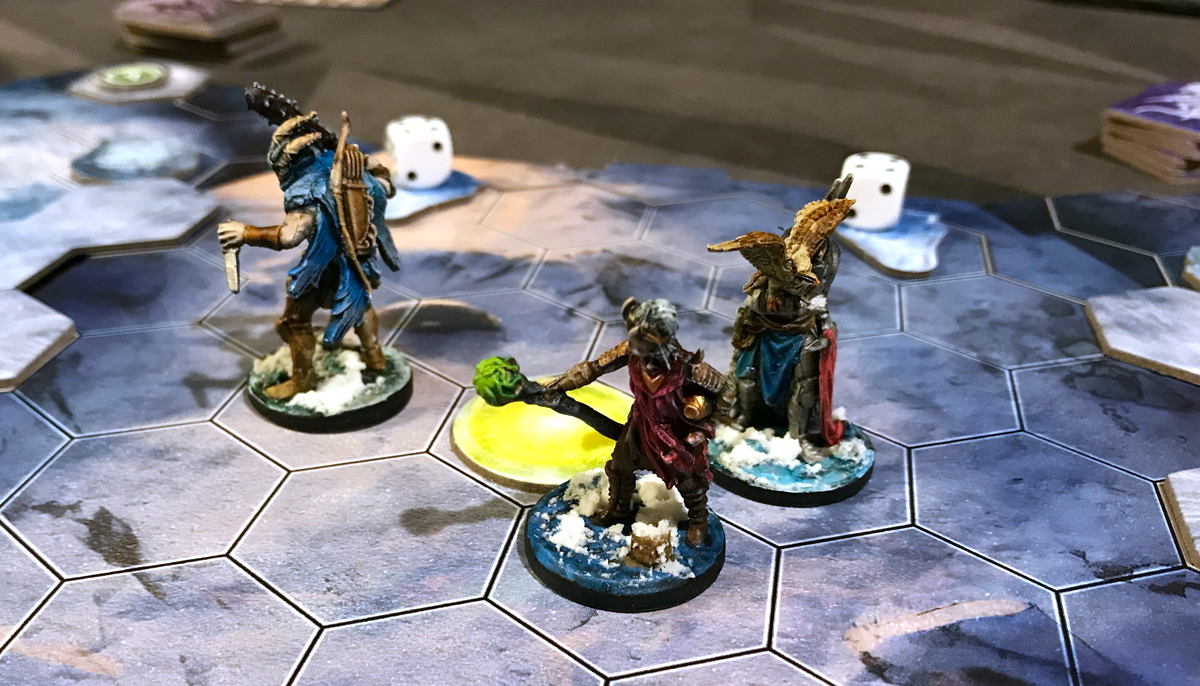
I also like the way that characters retire and change out over the course of the campaign. Some quests take longer than others, but it also keeps things fresh for the players. As you play, you unlock new classes to try out, but even if you go back and play one of the previous classes, you could choose different action cards when you level up—and that’s not even considering the way you can modify the cards themselves with enhancements.
The game’s difficulty level feels nicely tuned. The scenario’s level is based on the individual levels of the characters, and that affects the monster levels, how much damage traps do, how much gold or XP you earn, and so on. We’ve found that in most scenarios we’re just eking out a victory (or just barely losing), which keeps it thrilling. There have been several times that we thought we weren’t going to make it, but then managed to scrape by, and that’s such a satisfying feeling (and keeps you coming back for more).
The Outpost is a nice addition in Frosthaven—it gives you a feeling of leveling up as a party. Will you build up your walls to add to the defense? Or maybe a boat or a sled so you can access some hard-to-reach scenarios? Or upgrade your Alchemist so you can start brewing more powerful potions? The calendar events are also a nice touch, and I always enjoy it when we’re instructed to write a number a few weeks in the future. What will it be—did our plans work out or will things come back to bite us?
If you like a bit more immersion (or if you don’t like reading out loud yourself), I highly recommend the Forteller narration app ($17.99). The app includes all of the scenarios and sections, as well as the event cards. It’s not just a narrator reading the text—there are voice actors with different accents, atmospheric background noise, and other sound effects. It really adds to the setting, and the app is fairly easy to use. You can hear the prologue above to get a sense of it.
For the gameplay, I also recommend using the free Xhaven Assistant app (iOS and Android). You can connect multiple devices so each person uses their own, or you can share a device. It automatically pulls up the monsters and loot deck based on the scenario, and once you’ve put in your characters and levels, it adjusts the difficulty level. You enter your initiative numbers into the app and hit “draw,” and it draws all of the monster cards and arranges everyone in order, so you don’t have to manually draw (and shuffle) all of the monster action cards and mess with the initiative banners. The app will also track things like the elements, your health and XP, and loot that you’ve collected, and has little pop-up messages for scenario rules like when more enemies are supposed to spawn. We use a combination of the app and the physical tokens, but it speeds up some of the setup and upkeep for the game.
Frosthaven is best suited for a group that can be consistent… and that plays well together. If you find yourselves constantly arguing any time you play a cooperative game, this may cause a little too much friction! (Though given the game’s theme, that might be appropriate behavior for a group of mercenaries.) If you’re able to get together with the same group regularly, there’s an amazing world to explore together.
Currently, Cephalofair Games is running a Backerkit campaign called “Gloomhaven Grand Festival,” which includes a host of related products: Gloomhaven second edition, the Gloomhaven Role-Playing Game, Frosthaven second printing, and various minis sets for Gloomhaven and Frosthaven. It’s a chance to get things at a slightly reduced price compared to retail, and there are lots of livestreams featuring gameplay and interviews in case you want to learn more.
To pick up a copy of Frosthaven, you can visit the Cephalofair website, or check out the “Gloomhaven Grand Festival” Backerkit campaign!
Click here to see all our tabletop game reviews.
![]() To subscribe to GeekDad’s tabletop gaming coverage, please copy this link and add it to your RSS reader.
To subscribe to GeekDad’s tabletop gaming coverage, please copy this link and add it to your RSS reader.
Disclosure: GeekDad received a copy of this game for review purposes.
Click through to read all of "‘Frosthaven’: A Bigger, Better, Cooler ‘Gloomhaven’" at GeekDad.If you value content from GeekDad, please support us via Patreon or use this link to shop at Amazon. Thanks!

